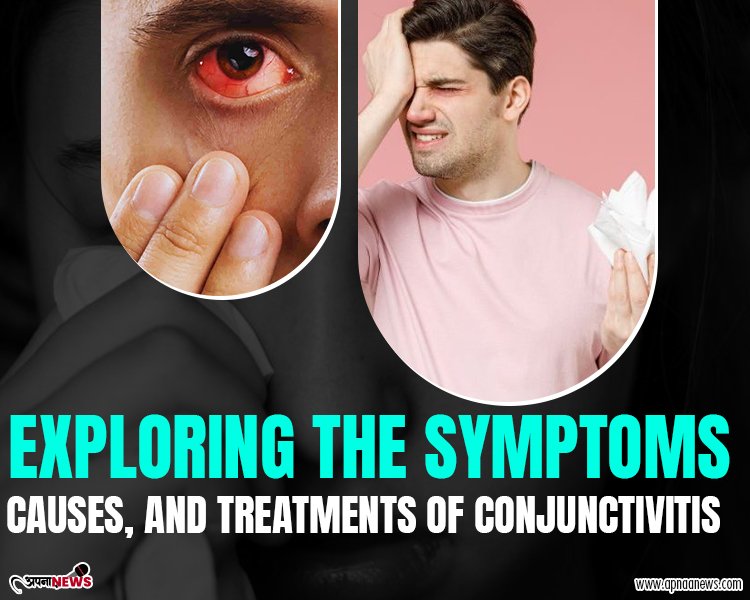Exploring the Symptoms, Causes, and Treatments of Conjunctivitis
Learn all about conjunctivitis, including its causes, symptoms, and treatment options. Get the facts you need to make informed decisions about how to best manage this eye condition

Conjunctivitis, also known by the name "Pink Eye", is a kind of infection that occurs in the eyes. Every second person today in India is suffering from this issue.
As the Rainy season is on, there are many new such infections occurring among the people. Most of them may leave a long lasting hazardous result.
Conjunctivitis Eye
Read the details given below to know in detail about this recently spreading Conjunctivitis Eyes Medical Problem.
Meaning
-
The irritation, inflammation or swelling of the conjunctiva, the thin, translucent layer of tissues that covers the inner surface of an eyelid and encompasses the white area of the eye, is known as conjunctivitis.
-
The root cause could or might not be contagious.
Symptoms
There are some basic symptoms related to Conjunctivitis. These are:
-
One or both eyes are red.
-
Itching in either one or both eyes.
-
A sand-like sensation in one or both eyes.
-
A discharge in one or both eyes that creates a crust overnight, preventing your eye(s) from opening in the morning.
-
Continuous Tears.
-
Photophobia occurs. It is a term for light sensitivity.
Causes
-
These are the three most typical causes of this inflammation caused due to this eye problem:
-
Conjunctivitis (Infectious Conjunctivitis).
-
A Hypersensitivity Reaction (Allergic Conjunctivitis).
-
Irritant Conjunctivitis is caused by something irritating the conjunctiva, such as a stray eyelash.
Types of Conjunctivitis
There are a total 5 types of Conjunctivitis, 3 of them are more common and other 2 are rare.
Three common types of Conjunctivitis are:
Bacterial Conjunctivitis
-
Patients suffering from bacterial conjunctivitis frequently complain of redness, tearing, and flow from one or both eyes.
-
The length of their symptoms is important because the disease course can be classified as Hyperacute, Acute (less than 3 to 4 weeks), or Chronic (more than 4 weeks).
-
Pain, itching, vision loss, and photophobia are all factors that influence clinical decisions.
Viral Conjunctivitis
-
The vast majority of conjunctivitis that is infectious is caused by viruses, which account for up to 75% of occurrences.
-
Redness, blood vessel engorgement, ocular discharge, discomfort, photophobia, and pseudo membranes are all symptoms of viral conjunctivitis.
Allergic Conjunctivitis
-
Allergic conjunctivitis is a conjunctival inflammation in response to an allergen.
-
It is part of a greater systemic allergic reaction and is frequently seasonal, with concurrent respiratory system signs and complaints of conjunctival redness and swelling, as well as acute itching and increased flow of tears.
Other Conjunctivitis types are:
Toxic Conjunctivitis
-
Toxic conjunctivitis (also known as toxic keratoconjunctivitis) is a chronic infection or inflammation of the eye's surface caused by an irritating chemical, most commonly a preservative or medication.
Nonspecific Conjunctivitis
It is possible to have red eyes and flow of water from it, that is not caused by a disease, allergies, or poisoning.
The following are some of the most common causes:
-
People with dry eyes may experience chronic or intermittent redness or discharge.
-
People who have their eyes irrigated after a chemical splash may experience redness and discharge.
-
People who have a foreign body (eg, dust, eyelash) in their eye may experience redness and discharge for 12 to 24 hours following the object is removed.
Treatment
Conjunctivitis might take up to three weeks to go away. It frequently heals on its own, but therapy can speed up recovery.
Self-care is part of the treatment.
It is essential to avoid wearing contact lenses while suffering from conjunctivitis.
-
Antihistamines can be used to treat allergic conjunctivitis.
-
Antibiotic eye drops can be used to treat bacterial conjunctivitis.
-
Viral conjunctivitis Treatment comprises lubricating with artificial tears four times per day or up to ten times per day using preservative-free tears. Cool compresses to the periorbital area using a moist washcloth may provide symptomatic reduction.
What is the Periorbital Area?
The orbicularis oculi (OOc) m. area is referred to as the "periorbital region." This area includes the upper and lower eyelids as well as the brows. The OOc m. muscle controls the curved shape of the eyes and expressions of the face.
Eye Flu in India 2023 Monsoon
-
Unusual rains, flooding, and increased humidity in the air have all contributed to an increase in conjunctivitis occurrences across the country.
-
While many germs and viruses thrive during this season due to increased humidity and water contamination, the number of cases is increasing rapidly.
Conclusion
The article given above includes all the related information about Conjunctivitis Eye Problem. We suggest you maintain a regular hygiene and try to avoid touching your eyes with unwashed hands.
If you find the above given information a quality content, do bookmark this page and we assure that we will provide you with many such other fantastic details on the current topics






